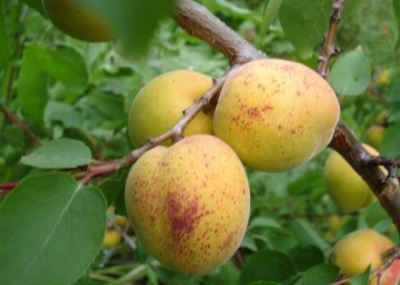
- Authors: F.M. Gasimov, K.K. Mullayanov (South Ural Research Institute of Horticulture and Potato Growing)
- Year of approval: 2003
- Escapes: dark red, straight, naked
- Flowers: medium
- Fruit weight, g: 22-23
- Fruit shape: rounded
- Skin : with slight pubescence
- Fruit color: main - yellow, integumentary - dark red, with isolated dots
- Pulp color : light orange
- Pulp (consistency): delicate, juicy, fine-fibred
Thanks to the labors of breeders, it became possible to grow a thermophilic apricot in a cold winter. The varieties that grow productively in the northern regions include a relatively young variety - Snezhinsky apricot, of Russian selection.
Breeding history
Snezhinsky is a variety that appeared thanks to the works of Russian breeders K.K.Mullayanov and F.M. Gasimov (Ural Research Institute of Fruit and Potato Growing) in 2000. The fruit-stone fruit culture was entered into the register of permitted for use in 2003. The most productive tree grows in the Urals, Siberia, as well as throughout the middle zone of the Russian Federation.
Description of the variety
Apricot Snezhinsky is a medium-sized tree, stretching up to 3-3.5 meters in height, characterized by a raised, very spreading crown (up to 4.5-5 m in diameter), modest foliage, large green foliage, and upright shoots of a dark red hue. The life cycle of a tree is 25 years.
The apricot begins to bloom in mid-May. During this period, the voluminous crown is covered with medium-sized snow-white flowers that emit a sweetish aroma. The formation of ovaries occurs on bouquet branches or spurs.
Fruit characteristics
This variety belongs to small-fruited varieties. On an adult tree, fruits grow on average 22-23 grams in weight. Apricots have a regular round shape, sometimes pointed at the base. Ripe fruits are covered with a solid, rich yellow color, which is diluted with a bright blush and numerous dots. The peel of the fruit is thin, but firm, with a slight pubescence and a pleasant shine. The abdominal suture is thin, eye-catching.
The purpose of the fruits is universal - they are eaten fresh, frozen, dried. They are processed into preserves and jams, preserved in halves, and used in cooking (baked goods, compotes, decor).
The advantage of the variety is good transportability of fruits, as well as their long keeping quality without loss of taste and useful qualities - up to 3 months in a cool place.
Taste qualities
The taste of Snezhinsky apricot is highly rated. Light orange pulp is endowed with a tender, fleshy, slightly fibrous and juicy structure. The taste is dominated by a pronounced sweetness, complemented by a summer aroma, which is a rarity among northern varieties of apricots. The large bone is easily separated from the pulp. The fruit is kept on a short stalk.
Ripening and fruiting
Snezhinsky is a medium-ripening variety. The tree begins to bear fruit in the 4th year after planting. Fruiting at the tree is stable - annual. The first apricots can be tasted on the 10th of July. The peak of ripening and fruiting occurs in the third decade of July.

Yield
The variety is famous for its bountiful harvests. About 75 kg of apricots can be harvested from one mature tree. On an industrial scale, the figures are even more pleasing - up to 57 centners per hectare of plantations.
Self-fertility and the need for pollinators
This variety is partially self-fertile (30%), therefore it needs additional cross-pollination. For this, apricot trees are planted nearby with similar flowering periods. The most productive are the pollinating varieties Kichiginsky and Khabarovsky.
Growing and care
Snezhinsky is unpretentious in care, but picky about the season in which it lands. Planting is carried out in early spring or autumn. It should be noted that autumn planting is permissible only in the southern regions. For planting, two-year-old seedlings are bought, which are placed away from crops such as apple, plum, cherry and pear. The distance between plantings should be 4 meters.
Agricultural technology of fruit crops consists of the following activities: watering, feeding, loosening and weeding of the near-stem zone, crown formation, removal of dry and damaged branches, prevention of fungus, mulching and preparation for cold weather.



Disease and pest resistance
The variety has good resistance to many diseases. The tree resists clusterosporiosis, many fungal infections, and also tolerates aphid infestations.

Winter hardiness and the need for shelter
The apricot variety is characterized by high frost resistance, withstanding a drop in temperature to -30. Trees growing in regions with little snowy winters need shelter. For this, burlap is used, which is wrapped around the trunk. In addition, mulching with humus, fallen leaves or sawdust will be a good protection from the cold.
Location and soil requirements
A heat-loving and drought-resistant tree is recommended to be grown on a level or elevated place where there is a lot of heat and sun. The soil should be loose, nutritious, good for air and moisture. In addition, deep groundwater and neutral acidity are important.































































